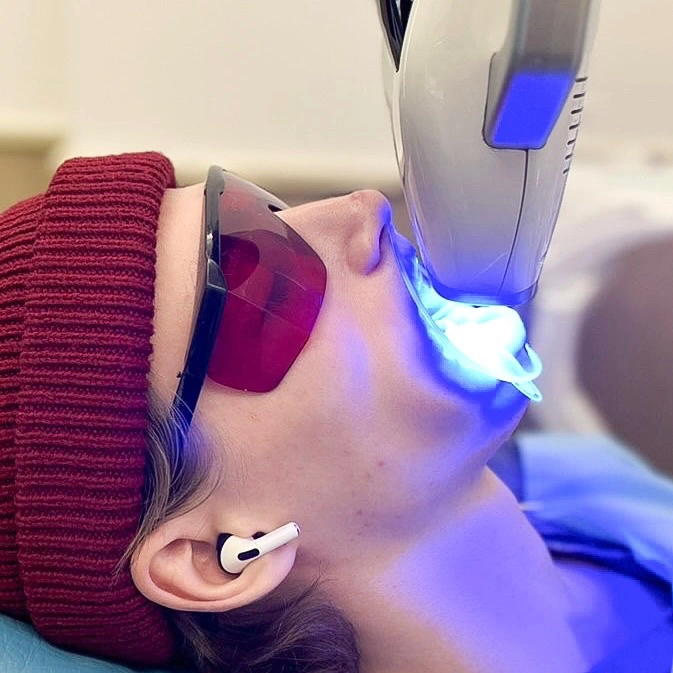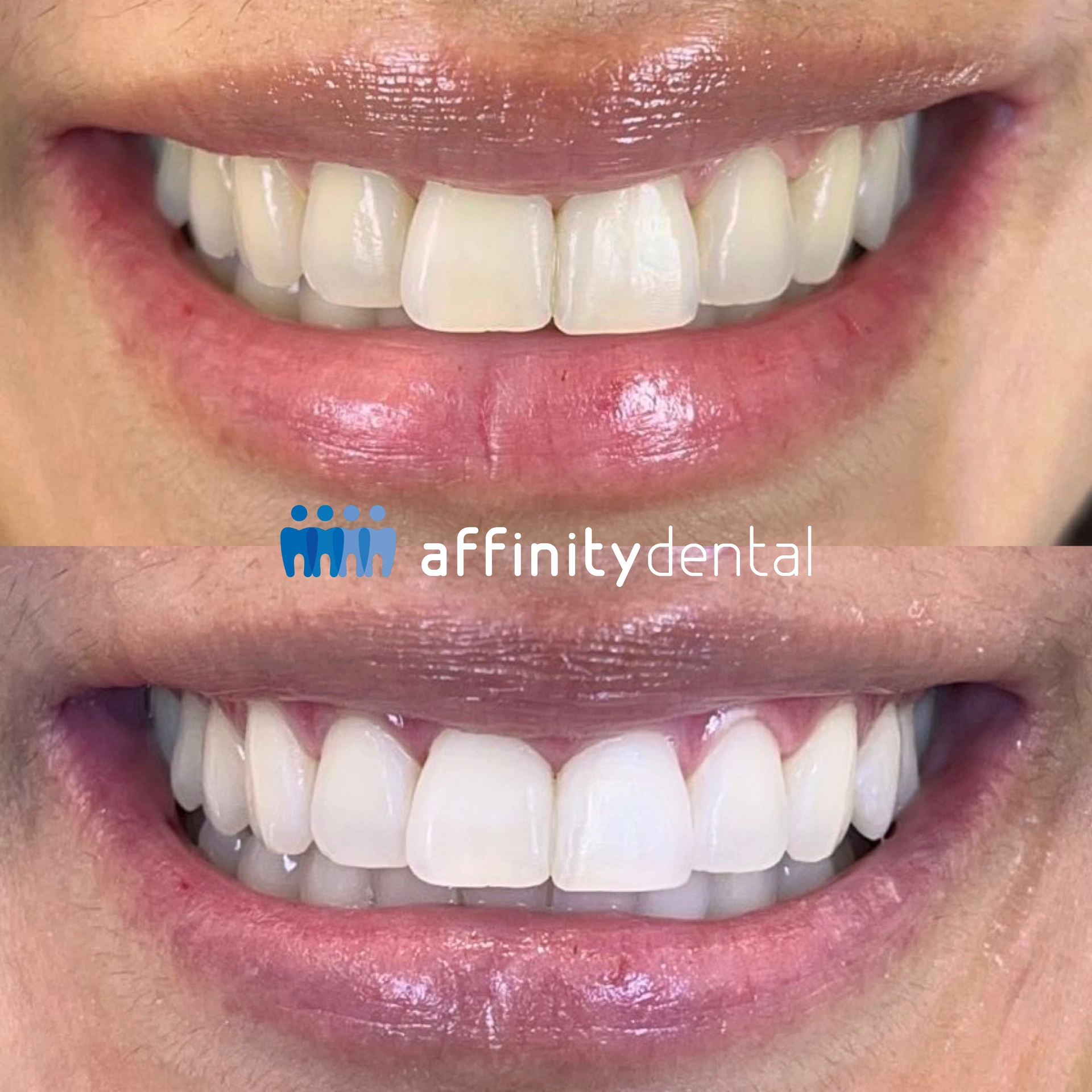Professional Teeth Whitening
Safe. Effective. Dentist-Supervised Whitening for a Naturally Brighter Smile.

At Affinity Dental Clinics, teeth whitening is more than just a cosmetic procedure—it’s a carefully administered clinical treatment performed by licensed dental professionals who prioritize your safety, oral health, and long-term results.
With so many options today—whitening kits, salons, spas, and online trends—it’s easy to get lost in the marketing hype. That’s why we’ve coined the term Professional Teeth Whitening to clearly distinguish what we offer: dental whitening done by actual dentists, in a clinical setting, with expert evaluation, medical-grade materials, and full gum and tooth protection.
Because the truth is: whitening your teeth is not something that should be done casually or frequently. And when it’s done right, it only needs to be done once every 6 to 12 months.
What is Professional Teeth Whitening?
Professional Teeth Whitening at Affinity Dental Clinics is a single-visit, dentist-supervised treatment that safely lightens and brightens your teeth by removing stains and discoloration caused by aging, food, beverages, and habits like smoking.
We use a dental-grade whitening gel that’s activated over three 20-minute cycles in one appointment. A gum barrier is applied before the gel to protect your soft tissues, and your teeth are assessed thoroughly before any treatment begins.
Unlike generic whitening products or salons, we tailor each treatment to your needs, and we never recommend multiple sessions that could damage your enamel or make your teeth overly sensitive.
Why We Don’t Offer Multi-Session Whitening
One of the most important things to know about our whitening philosophy is this:
We do not offer multiple-session whitening. Why?
Because repeated whitening treatments—especially in a short period—can damage your enamel, irritate your gums, and lead to long-term sensitivity. At Affinity Dental Clinics, we believe in doing it right the first time. One properly done session, with appropriate aftercare and maintenance, should be enough for many months—sometimes even a year.
We recommend a gap of at least 6 to 12 months between treatments.
If you feel your smile is darkening again before then, it may be time for a professional cleaning first—not another whitening session.
Why You Need Cleaning Before Whitening


Before we perform any teeth whitening, our dentists require a full oral prophylaxis—either the traditional method or our advanced AIRFLOW® Prophylaxis. This ensures that plaque, calculus, and surface stains are removed, giving the whitening gel maximum contact with your enamel.
Without cleaning first, whitening can be uneven, patchy, or even ineffective. Worse, plaque or tartar can trap the whitening agents and cause irritation or blotchiness.
So before we brighten your smile, we make sure it’s clean and ready.
Not Everyone Can Have Whitening—And That’s Okay
While immediate loading offers excellent benefits, it’s not for every case. You may be a suitable candidate if:
If you’re not a candidate for whitening, don’t worry. Our dentists can recommend other aesthetic treatments like composite bonding, veneers, or crowns, depending on your case.
How Treatment Works?
Here’s what to expect from a professional teeth whitening session at Affinity Dental Clinics:
Your dentist will examine your teeth and gums to determine if whitening is suitable for you. If underlying issues are present, we’ll recommend treatment first.
We perform a full cleaning to eliminate plaque and surface stains. Whitening on unclean teeth is ineffective, so this step is essential.
A protective barrier is applied to your gums and soft tissues to prevent irritation from the whitening gel.
A professional-grade whitening gel is applied to your teeth. This formula is stronger than over-the-counter products and safe only under dental supervision.
The gel is activated in three carefully timed 20-minute cycles, ensuring maximum whitening while protecting your teeth.
After the cycles, we rinse off the gel, remove the barriers, and reveal your brighter, whiter smile.
FAQs About Teeth Whitening
Is it painful?
No. Most patients feel no pain, just a little tingling or warmth. For very sensitive teeth, we may use desensitizers or adjust the exposure.
How white will my teeth get?
That depends on your original shade and enamel. We aim for a natural-looking brightness, not an artificial “paper white.”
How long does it last?
With good oral hygiene and proper maintenance, results typically last 6 months to 1 year.
Can I eat or drink after?
Yes, but avoid deeply pigmented foods and drinks (coffee, tea, red wine, soy sauce) for at least 48 hours after treatment.
Why Choose Affinity Dental Clinics for Whitening?
Licensed and Trained Dentists Only – We don’t delegate whitening to non-dentists or technicians.
Single-Visit, Scientifically Backed – Our method is fast, effective, and respects your enamel health.
Pretreatment Assessment – We never proceed without a proper dental exam.
No Overbleaching or Gimmicks – We protect your teeth from overexposure and damage.
Whitening That Honors Your Smile, Not Trends
We don’t chase trends. We don’t promise unnatural perfection. At Affinity Dental Clinics, we enhance what’s already beautiful—your natural smile.
That’s why we’re the trusted name for teeth whitening in the Philippines, serving not just locals, but also expats, tourists, and dental travelers who value clinical precision and aesthetic restraint.
Ready for a Brighter, Healthier Smile?
Teeth whitening is a medical procedure—and should be treated with the care, professionalism, and ethics it deserves. At Affinity Dental Clinics, we deliver results that are safe, realistic, and tailored to your needs.
Book your Professional Teeth Whitening session today and experience a brighter smile—done right, done safely, and done beautifully.
Schedule now at any of our clinics in Makati, BGC, Ortigas, Alabang, Parañaque, or Cebu.
Book an Appointment
One moment, your message is being sent...
Please wait for the confirmation message before going back or closing your browser.






